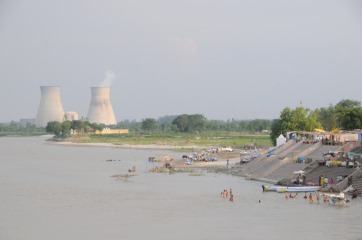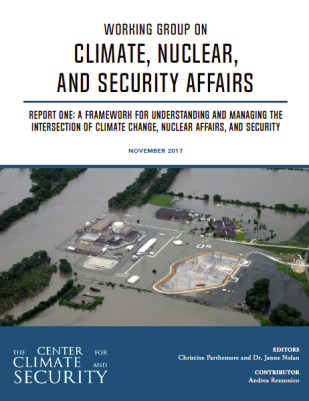In its initial report released on November 15, 2017, the Working Group on Climate, Nuclear, and Security Affairs (CNSA), chaired by the Center for Climate and Security, articulates a first-of-its kind framework for understanding and addressing the complex connections between climate change, security, and nuclear issues.
Countries such as Nigeria, Jordan, Bangladesh, Egypt, and Saudi Arabia are dealing with numerous internal climatic, economic, security, demographic, and environmental pressures as they pursue nuclear energy. The report notes the importance of such countries in terms of how these issues might influence one another—and raises concerns that Russia may be a dominant nuclear supplier to such countries.
Without question, the global security environment is complex, evolving and sometimes rapidly changing. The report finds that the effects of climate change are complicating that landscape, and intersecting with nuclear trends, including new countries seeking nuclear energy, some traditional nuclear energy-producing countries pivoting to other power sources, new pressures on the nonproliferation regime, and many specific nuclear risks persisting or increasing.
“Even more important,” said Dr. Janne Nolan, the Working Group’s Co-chair, Chair of the Nuclear Security Working Group, and Center for Climate and Security Advisory Board Member, “these dynamics are connected. Climate, security, and nuclear trends influence one another, and risk combining in unprecedented and catastrophic ways. This is why understanding systemic risks and remedies and their interconnections is so critical, and the heart of the Working Group’s first report.” For example, some experts are concerned that combining tensions over water, territory, and other issues may increase nuclear detonation risks in regions like South Asia.
The framework presented in the report serves as a guide for how smart planning, preparations, and policies can help the United States and others navigate this combination of stresses and create a more resilient, stable world. Bolstering international mechanisms (e.g., supporting the IAEA and the Paris agreement), addressing underlying drivers of insecurity and instability, and accounting for social and political movements will be required to help mitigate the types of concerns raised in this report. Smartly developing and applying key technologies will likewise help in countries like those named above, including the safest reactor designs for countries that adopt nuclear energy, modern security and monitoring systems, and strong climate modeling capabilities. This is especially critical in the potential crisis regions where combining security, climate, and nuclear risks must be addressed with urgency: South Asia, the Middle East, the South China Sea, and Central and North Africa.
 “We don’t know with full certainty the world’s climatic trajectory or nuclear energy future, nor can we fully decide these global trends. We must map the risks and opportunities involved with all potential outcomes and find ways to promote U.S. security interests in all scenarios,” said Christine Parthemore, the Working Group’s co-chair and Director of the Climate-Nuclear-Security Program at the Center for Climate and Security. “The stakes are high on navigating these interacting challenges with smart policies and programs.”
“We don’t know with full certainty the world’s climatic trajectory or nuclear energy future, nor can we fully decide these global trends. We must map the risks and opportunities involved with all potential outcomes and find ways to promote U.S. security interests in all scenarios,” said Christine Parthemore, the Working Group’s co-chair and Director of the Climate-Nuclear-Security Program at the Center for Climate and Security. “The stakes are high on navigating these interacting challenges with smart policies and programs.”
The Working Group on Climate, Nuclear, and Security Affairs (CNSA) was launched in 2016 by the Center for Climate and Security. This groundbreaking effort stems from the mounting evidence that various security challenges, climatic trends, and nuclear issues are combining in new and potentially high-risk ways. Mapping and addressing this complexity is critical for protecting U.S. security interests in places such as Jordan, Turkey, Saudi Arabia, and across the Indo-Asia-Pacific and Europe—and in international fora.
In the first report in a planned series, the CNSA recommends beginning with a few broad but clear steps to begin advancing U.S. interests regarding intertwining climate, nuclear, and security affairs. These include developing realistic planning scenarios, improving communication regarding existential nuclear and climate risks, and educating policy makers about the practical ways they can protect America’s capacities for navigating these challenges. For example, the report suggests that U.S. governmental and non-governmental leaders:
Focus on potential crisis regions and game out ways in which applying specific policies, technologies, normative structures, and other measures can be stabilizing or destabilizing
Promote more robust public and policy maker engagement on existential risks like nuclear conflict and climate change
Convey risks in relatable and immediate ways, for example emphasizing ways to reduce threats to vulnerable infrastructure across the country

No comments:
Post a Comment